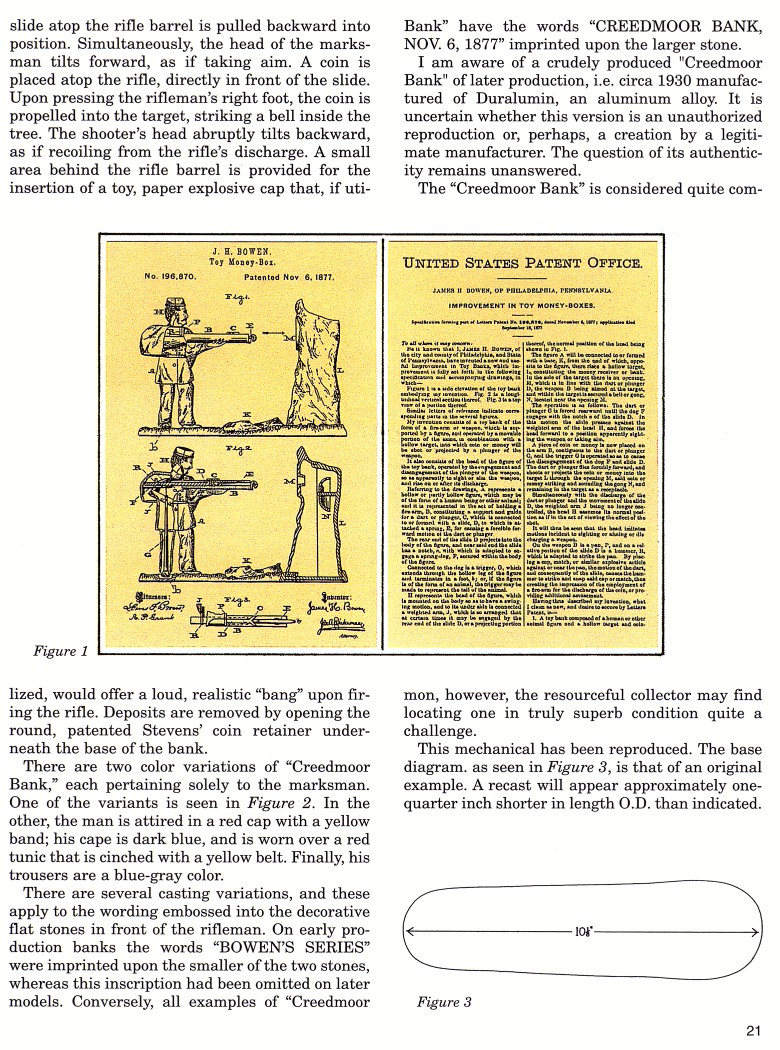|
Creedmore Bank
by Sy Schreckinger – ANTIQUE TOY WORLD Magazine – November,
2000
The year was 1875. The event was the first rifle marksmanship
contest between the United States and Europe. The site of the target range
was Creedmoor Plains, Long Island, New York, named for the prosperous,
land-owning Creed family whose members had great interest in firearms and
target shooting.
These international sharp-shooting competitions continued until 1880,
with the United States remaining unrivaled, capturing all medals each
year. Despite discontinuance of the yearly event, enthusiasm for the sport
did not diminish. In contrast, since the initial shot had been fired,
target shooting ascended in popularity and eventually became a worldwide
pastime.
Ever cognizant of popular trends, enterprising entrepreneurs
recognized the potential for substantial profits. A plethora of saleable
goods bearing the "Creedmoor" nomenclature soon flooded the marketplace.
These included clothing, games, air rifles, cap pistols, toys, and
live-ammunition firearms. Unsurprisingly, a mechanical bank was amongst
the creations.
On November 6, 1877, Mr. James H. Bowen of Philadelphia,
Pennsylvania, was granted Patent Number
196,870 for a toy mechanical bank
embodying the likeness of a rifle-wielding sharpshooter standing before a
targeted tree (Figure 1). The J. and E. Stevens Foundry of Cromwell,
Connecticut, commissioned Mr. Bowen, a freelance toy inventor, to design
mechanical banks as per the company's specifications. Stevens'
identification of this mechanical as "Creedmoor Bank" (Figure 2), was
cleverly, an attempt to capitalize on the success of the popular
tournament by the same name.
Action of the "Creedmoor Bank" is simplistic and apropos to the
subject: the coin-propelling slide atop the rifle barrel is pulled
backward into position. Simultaneously, the head of the marksman tilts
forward, as if taking aim. A coin is placed atop the rifle, directly in
front of the slide. Upon pressing the rifleman's right foot, the coin is
propelled into the target, striking a bell inside the tree. The shooter's
head abruptly tilts backward, as if recoiling from the rifle's discharge.
A small area behind the rifle barrel is provided for the insertion of a
toy, paper explosive cap that, if utilized, would offer a loud, realistic
"bang" upon firing the rifle. Deposits are removed by opening the round,
patented Stevens' coin retainer underneath the base of the bank.
There are two color variations of "Creedmoor Bank," each pertaining
solely to the marksman. One of the variants is seen in Figure 2. In the
other, the man is attired in a red cap with a yellow band; his cape is
dark blue, and is worn over a red tunic that is cinched with a yellow
belt. Finally, his trousers are a blue-gray color.
There are several casting variations, and these apply to the wording
embossed into the decorative flat stones in front of the rifleman. On
early production banks the words "BOWEN'S SERIES" were imprinted upon the
smaller of the two stones, whereas this inscription had been omitted on
later models. Conversely, all examples of "Creedmoor Bank" have the words
"CREEDMOOR BANK, NOV. 6, 1877" imprinted upon the larger stone.
I am aware of a crudely produced "Creedmoor Bank" of later
production, i.e. circa 1930 manufactured of Duralumin, an aluminum alloy.
It is uncertain whether this version is an unauthorized reproduction or,
perhaps, a creation by a legitimate manufacturer. The question of its
authenticity remains unanswered.
The "Creedmoor Bank" is considered quite common, however, the
resourceful collector may find locating one in truly superb condition
quite a challenge.
This mechanical has been reproduced. The base diagram. as seen in
Figure 3, is that of an original example. A recast will appear
approximately one- quarter inch shorter in length O.D. than indicated.
NOTE: (from
December, 2000) Due to typographical error in the title "Creedmoor Bank"
(article, November 2000 issue of Antique Toy World) the article will be
republished in its entirety in the
January 2001 issue.
|


